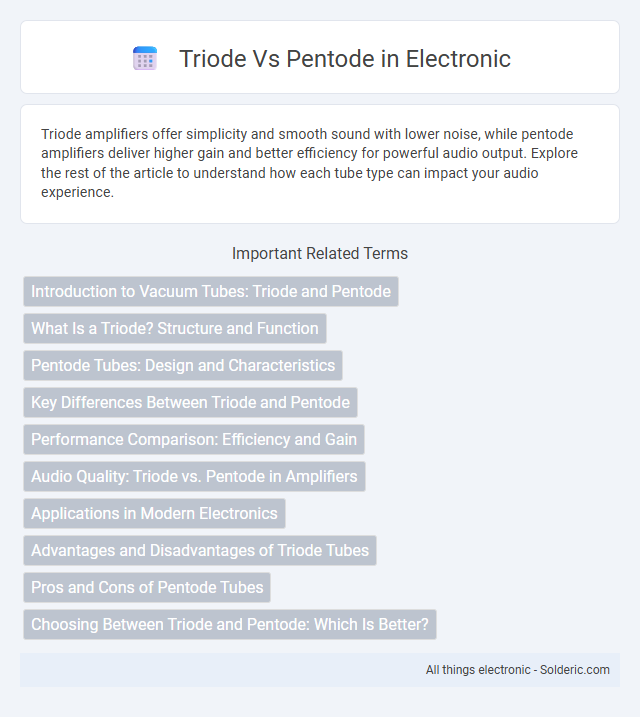Triode amplifiers offer simplicity and smooth sound with lower noise, while pentode amplifiers deliver higher gain and better efficiency for powerful audio output. Explore the rest of the article to understand how each tube type can impact your audio experience.
Comparison Table
| Feature | Triode | Pentode |
|---|---|---|
| Number of Electrodes | 3 (Cathode, Anode, Control Grid) | 5 (Cathode, Anode, Control Grid, Screen Grid, Suppressor Grid) |
| Gain | Low to Moderate | High |
| Frequency Response | Limited by Miller effect | Wider bandwidth, reduced Miller effect |
| Output Impedance | Lower | Higher |
| Noise | Lower | Higher |
| Application | Audio amplification, RF amplification (low power) | High-frequency amplification, RF stages, audio power amps |
| Complexity | Simple construction | More complex design |
| Power Consumption | Lower | Higher |
Introduction to Vacuum Tubes: Triode and Pentode
Vacuum tubes, essential components in early electronics, come mainly in triode and pentode forms, each with unique electrical characteristics. The triode, featuring three elements (cathode, anode, and control grid), facilitates signal amplification with moderate gain but limited frequency response. The pentode adds two more grids (screen and suppressor), enhancing gain, reducing distortion, and improving frequency performance, which makes it ideal for high-fidelity audio and radio applications.
What Is a Triode? Structure and Function
A triode is an early type of vacuum tube consisting of three main components: the cathode, anode (plate), and control grid, which regulates electron flow. Its structure allows the control grid to modulate the current between the cathode and anode, enabling signal amplification. Triodes are essential in audio amplification and radio frequency applications due to their linear gain characteristics.
Pentode Tubes: Design and Characteristics
Pentode tubes feature three grids--a control grid, screen grid, and suppressor grid--that enhance amplification by reducing capacitance and secondary emission effects, resulting in higher gain and improved efficiency compared to triodes. Their design allows for greater output power and reduced distortion, making pentodes ideal for applications in audio amplification and radio frequency circuits. Understanding pentode characteristics can help you optimize your electronic designs for performance and reliability.
Key Differences Between Triode and Pentode
Triodes contain three elements: the cathode, anode, and control grid, while pentodes have two additional grids, the screen and suppressor grids, enhancing amplification and reducing distortion. Pentodes provide higher gain and improved frequency response compared to triodes, which offer lower noise and simpler circuitry. Understanding these key differences helps you choose the best vacuum tube for your audio or electronic application.
Performance Comparison: Efficiency and Gain
Pentodes generally offer higher gain and efficiency compared to triodes due to their additional grids, which reduce secondary emission and improve amplification linearity. Triodes typically have lower gain but deliver smoother, more natural sound with less distortion, making them preferred in audio applications prioritizing tonal quality. Your choice between triode and pentode depends on whether you prioritize maximum amplification efficiency or richer, more refined audio performance.
Audio Quality: Triode vs. Pentode in Amplifiers
Triode amplifiers produce a warm, natural, and harmonically rich audio quality, favored for their smooth midrange and musicality. Pentode amplifiers offer higher gain and efficiency with a more dynamic and detailed sound but can introduce more distortion and a harsher high end. Audiophiles often prefer triodes for critical listening due to their low distortion and pleasing sonic characteristics, while pentodes suit applications requiring greater power and output.
Applications in Modern Electronics
Triodes are primarily used in audio amplification due to their low distortion and smooth signal handling, making them ideal for high-fidelity sound systems and musical instrument amplifiers. Pentodes, with their higher gain and better frequency response, find applications in radio receivers, television tuners, and RF amplification where stronger signal amplification is required. Modern electronics leverage pentodes in RF and IF stages for improved sensitivity, while triodes remain preferred in audio preamplifiers and certain specialized analog circuits.
Advantages and Disadvantages of Triode Tubes
Triode tubes offer simplicity, low noise, and excellent linearity, making them ideal for high-fidelity audio applications where sound purity is critical. Their lower gain and higher distortion compared to pentodes limit power output and efficiency, restricting their use in high-power amplification. Your choice depends on whether you prioritize audio quality with triodes or higher power and gain with pentodes.
Pros and Cons of Pentode Tubes
Pentode tubes offer higher gain and improved amplification linearity compared to triodes, making them ideal for high-frequency and high-power applications. Their design reduces the Miller effect and internal capacitance, resulting in better performance in radio frequency circuits, but this comes at the cost of increased noise and more complex circuitry. Your audio or electronic projects benefit from pentodes' superior power handling, although you may need to address the trade-offs in distortion and circuit complexity.
Choosing Between Triode and Pentode: Which Is Better?
Choosing between triode and pentode tubes depends on your audio preferences and application needs; triodes deliver smoother, warmer sound with lower distortion, ideal for high-fidelity listening. Pentodes offer higher gain and efficiency with a more aggressive tone, preferred in guitar amplifiers and applications requiring greater power output. Your decision should balance audio quality against power requirements to find the best match for your sound system.
Triode vs Pentode Infographic

 solderic.com
solderic.com